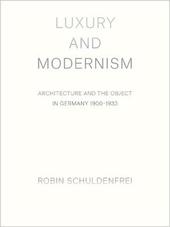
|
Luxury and Modernism: Architecture and the Object in Germany 1900-1933
Hardback
Main Details
| Title |
Luxury and Modernism: Architecture and the Object in Germany 1900-1933
|
| Authors and Contributors |
By (author) Robin Schuldenfrei
|
| Physical Properties |
| Format:Hardback | | Pages:336 | | Dimensions(mm): Height 254,Width 191 |
|
| Category/Genre | Architectural structure and design
History of architecture |
|---|
| ISBN/Barcode |
9780691175126
|
| Classifications | Dewey:724.6 |
|---|
| Audience | | Tertiary Education (US: College) | | Professional & Vocational | |
|---|
| Illustrations |
74 color + 126 b/w illus.
|
|
Publishing Details |
| Publisher |
Princeton University Press
|
| Imprint |
Princeton University Press
|
| Publication Date |
5 June 2018 |
| Publication Country |
United States
|
Description
This beautifully illustrated book provides a new interpretation of modern architecture and design in Germany during the heyday of the Bauhaus and the Werkbund, tracing modernism's lasting allure to its many manifestations of luxury. Robin Schuldenfrei casts the work of legendary figures such as Peter Behrens, Walter Gropius, and Ludwig Mies van der
Author Biography
Robin Schuldenfrei is the Katja and Nicolai Tangen Lecturer in Twentieth-Century Modernism at the Courtauld Institute of Art, University of London.
Reviews"Shortlisted for the WCGS Book Prize, Waterloo Centre for German Studies" "A Choice Outstanding Academic Title of the Year" "Robin Schuldenfrei's smart and suggestive book Luxury and Modernism: Architecture and the Object in Germany 1900-1933 runs against the grain of what we would like to believe about our own aesthetic preferences, so often enshrined in our social formation, including in the professional education of architects. . . . Schuldenfrei's book is likely to spur further insights into the degree to which the dissemination of Neues Bauen internationally was more closely tied to fashion than previous scholars have chosen to admit. At the same time, it may also help liberate us to create an architecture of true equality, something the Modern Movement seldom truly offered."---Kathleen James-Chakraborty, Architectural Review "In Luxury and Modernism, Robin Schuldenfrei punctures the idealistic, lofty, socialist rhetoric of the Bauhaus's artist-craftsmen. The Bauhaus, she reveals, imposed an elitist, aristocratic notion of taste on the masses, who largely didn't want it."---Christopher Turner, Apollo "Highly recommended."---L.E. Carranza, Choice "Schuldenfrei carefully analyses a key aspect of Modernism's embrace of abstraction that has confounded previous historians. . . . By exposing through the notion of luxury the paradox of Modernism, Schuldenfrei has made an important contribution to Bauhaus scholarship. This learned, original, counterintuitive, unorthodox and occasionally witty book could not have been published at a more appropriate moment."---Ines Weizman, Burlington Magazine "In Luxury and Modernism, Schuldenfrei confronts the longstanding issue of modern architecture's elitism, going to the heart of the canon and building up evidence in varied case studies."---Ani Kodzhabasheva, Architectural Histories "Schuldenfrei's Luxury and Modernism provides a model for a materially grounded, critically reflective and argument-driven reassessment of a canonical field."---Deborah Lewer, Art History "Robin Schuldenfrei revisits the inconsistencies between modernism's rhetoric and its accomplishments, offering a generous reassessment of its proponents' proclivity for luxury . . . . Luxury and Modernism presents eloquent, well-researched, and courageous scholarship . . . . With her major contribution, Robin Schuldenfrei has given us much to reconsider."---Leslie Van Duzer, Journal of Architectural Education "Considering modernism as luxury enables Schuldenfrei to investigate German modernism's material manifestations, but also its broader social, cultural, and economic implications on fresh terms. The book's introduction, presenting key issues in original yet accessible ways, and confronting modernism's compelling rhetoric with its less-known, more-conflicted lived realities, should be a required text for graduate courses on modern design, architecture, and related topics. . . . Between its creamy cotton covers, Luxury and Modernism gathers, synthesizes, and further problematizes many critical reassessments of modernism. "---Freyja Hartzell, Journal of the Society of Architectural Historians
|